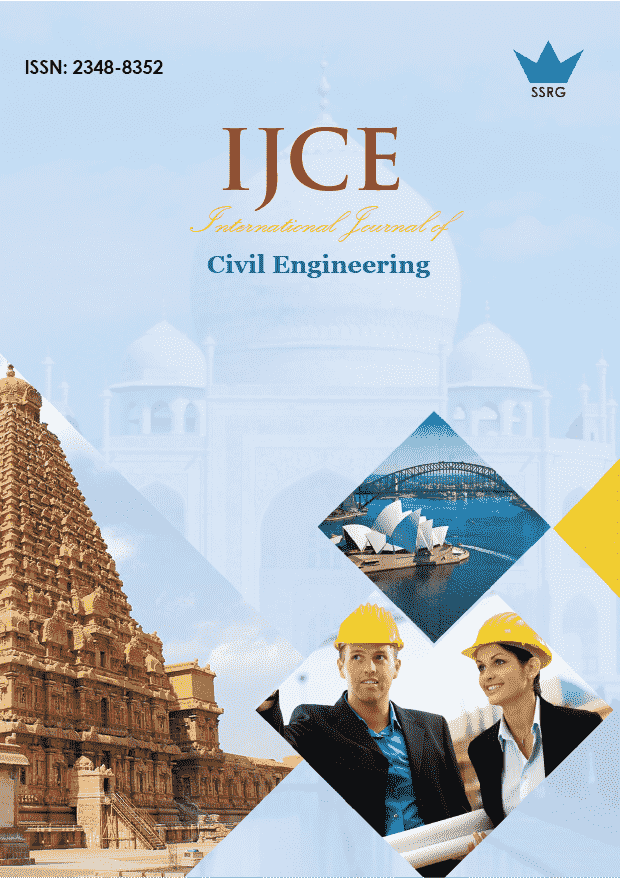Assessment of Influence of Different Activator Precursors on Strength and Workability of One Part Geopolymer Concrete Mixes Exposed to Marine Environments

| International Journal of Civil Engineering |
| © 2025 by SSRG - IJCE Journal |
| Volume 12 Issue 5 |
| Year of Publication : 2025 |
| Authors : Pratik B. Somaiya, Ankur C. Bhogayata, Mihir B. Baldania |
How to Cite?
Pratik B. Somaiya, Ankur C. Bhogayata, Mihir B. Baldania, "Assessment of Influence of Different Activator Precursors on Strength and Workability of One Part Geopolymer Concrete Mixes Exposed to Marine Environments," SSRG International Journal of Civil Engineering, vol. 12, no. 5, pp. 157-166, 2025. Crossref, https://doi.org/10.14445/23488352/IJCE-V12I5P113
Abstract:
Concrete structures in coastal areas deteriorate rapidly due to harsh environmental conditions. One-Part Geopolymer Concrete (OGPC) offers an environmentally sustainable substitute for traditional concrete, providing superior strength and promising fresh-state properties. Unlike traditional concrete, OGPC consists of dry binders and activators, eliminating the need for Portland cement. The activator precursor is a critical factor in OGPC performance, which influences polymerization and strength development. Therefore, selecting an appropriate activator requires attention. In the present study, the OGPC mixes were prepared using different precursors as activators to determine their influence on fresh and strong properties. The study's key parameters were the chemical composition ratios, types of activators, workability, compressive and splitting tensile strength. The OGPC mixes were evaluated by performing the slump tests, compacting factor test, flow table test to assess the workability in the fresh state, axial compression test, and splitting tensile strength for strength performance in the hardened state. The results showed that using sodium meta silicate and sodium carbonate provides excellent performance for OGPC in all the test conditions. The optimum dosage and chemical proportions of the precursors have also been proposed from the experimental result analysis. The strength properties were compared to the traditional concrete option to ascertain the high-strength performance of the OGPC specimens. The study showed the potential of the utilize of OGPC as a substitute concrete for traditional concrete, with a promising performance in strength and workability being the essential requirements of the structures exposed to the severe exposure conditions in Marine environments.
Keywords:
Alkali Activator precursors, Compressive Strength, Marine environment, One-part Geopolymer Concrete, Sustainability.
References:
[1] P. Mehta, and Paulo J.M. Monteiro, Concrete Microstructure, Properties, and Materials, McGraw-Hill Education, pp. 1-659, 2010.
[Google Scholar] [Publisher Link]
[2] Tsion Amsalu Fode, Yusufu Abeid Chande Jande, and Thomas Kivevele, “Effects of Different Supplementary Cementitious Materials on Durability and Mechanical Properties of Cement Composite – Comprehensive Review,” Heliyon, vol. 9, no. 7, 2023.
[CrossRef] [Google Scholar] [Publisher Link]
[3] Adam M. Neville, Properties of Concrete, Pearson, pp. 1-846, 2011.
[Google Scholar] [Publisher Link]
[4] Joseph Davidovits, Geopolymer Chemistry and Applications, 3rd ed., Geopolymer Institute, pp. 1-612, 2011.
[Google Scholar] [Publisher Link]
[5] Heng Li et al., “Geopolymer Composites for Marine Application: Structural Properties and Durability,” Cement and Concrete Composites, vol. 152, 2024.
[CrossRef] [Google Scholar] [Publisher Link]
[6] J.L Provis, J.S.J van Deventer, John L. Provis, Geopolymers: Structures, Processing, Properties and Industrial Applications, Woodhead Publishing, pp. 1-464, 2009.
[Google Scholar] [Publisher Link]
[7] Shuntian Ouyang et al., “Experimental Study of One-Part Geopolymer Using Different Alkali Sources,” Journal of Physics: Conference Series: International Conference on Internet of Things, Artificial Intelligence and Mechanical Automation, Hangzhou, China, vol. 1605, pp. 1-8, 2020.
[CrossRef] [Google Scholar] [Publisher Link]
[8] Mahya Askarian et al., “Mix Composition and Characterisation of One-Part Geopolymers with Different Activators,” Construction and Building Materials, vol. 225, pp. 526-537, 2019.
[CrossRef] [Google Scholar] [Publisher Link]
[9] Keun-Hyeok Yang et al., “Properties of Cementless Mortars Activated by Sodium Silicate,” Construction and Building Materials, vol. 22, no. 9, pp. 1981-1989, 2008.
[CrossRef] [Google Scholar] [Publisher Link]
[10] David Koloušek et al., “Preparation, Structure and Hydrothermal Stability of Alternative (Sodium Silicate-Free) Geopolymers,” Journal of Materials Science, vol. 42, pp. 9267-9275, 2007.
[CrossRef] [Google Scholar] [Publisher Link]
[11] Dingwu Feng et al., “Thermal Activation of Albite for the Synthesis of One-Part Mix Geopolymers,” Journal of the American Ceramic Society, vol. 95, no. 2, pp. 565-572, 2012.
[CrossRef] [Google Scholar] [Publisher Link]
[12] Keun-Hyeok Yang, and Jin-Kyu Song, “Workability Loss and Compressive Strength Development of Cementless Mortars Activated by Combination of Sodium Silicate and Sodium Hydroxide,” Journal of Materials in Civil Engineering, vol. 21, no. 3, pp. 119-127, 2009.
[CrossRef] [Google Scholar] [Publisher Link]
[13] B. Vijaya Rangan, “Fly Ash-Based Geopolymer Concrete,” Curtin University of Technology, Report, 2008.
[Google Scholar] [Publisher Link]
[14] P. Duxson et al., “Geopolymer Technology: The Current State of the Art,” Journal of Materials Science, vol. 42, pp. 2917-2933, 2007.
[CrossRef] [Google Scholar] [Publisher Link]
[15] IS: 10262, Concrete Mix Proportioning –Guidelines, 2nd Revision, Bureau of Indian Standards, 2019. [Online]. Available: https://archive.org/details/gov.in.is.10262.2019
[16] IS: 516, Hardened Concrete Methods of Test Part 1 Testing of Strength of Hardened Concrete Section 1 Compressive, Flexucal and Split Tensile Strength, 1st Revision, Bureau of Indian Standards, 2021. [Online]. Available: https://archive.org/details/gov.in.is.516.1.1.2021
[17] Pradip Nath, and Prabir Kumar Sarker, “Use of OPC to Improve Setting and Early Strength Properties of Low Calcium Fly Ash Geopolymer Concrete Cured at Room Temperature,” Cement and Concrete Composites, vol. 55, pp. 205-214, 2015.
[CrossRef] [Google Scholar] [Publisher Link]
[18] IS:1199, Methods of Sampling and Analysis of Concrete, Bureau of Indian Standards, 1959. [Online]. Available: https://archive.org/details/gov.in.is.1199.1959
[19] Tero Luukkonen et al., “One-Part Alkali-Activated Materials: A Review,” Cement and Concrete Research, vol. 103, pp. 21-34, 2018.
[CrossRef] [Google Scholar] [Publisher Link]
[20] Sajjad Yousefi Oderji et al., “Fresh and Hardened Properties of One-Part Fly Ash-Based Geopolymer Binders Cured at Room Temperature: Effect of Slag and Alkali Activators,” Journal of Cleaner Production, vol. 225, pp. 1-10, 2019.
[CrossRef] [Google Scholar] [Publisher Link]
[21] Susan A. Bernal et al., “Role of Carbonates in the Chemical Evolution of Sodium Carbonate-Activated Slag Binders,” Materials and Structures, vol. 48, pp. 517-529, 2015.
[CrossRef] [Google Scholar] [Publisher Link]

 10.14445/23488352/IJCE-V12I5P113
10.14445/23488352/IJCE-V12I5P113